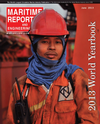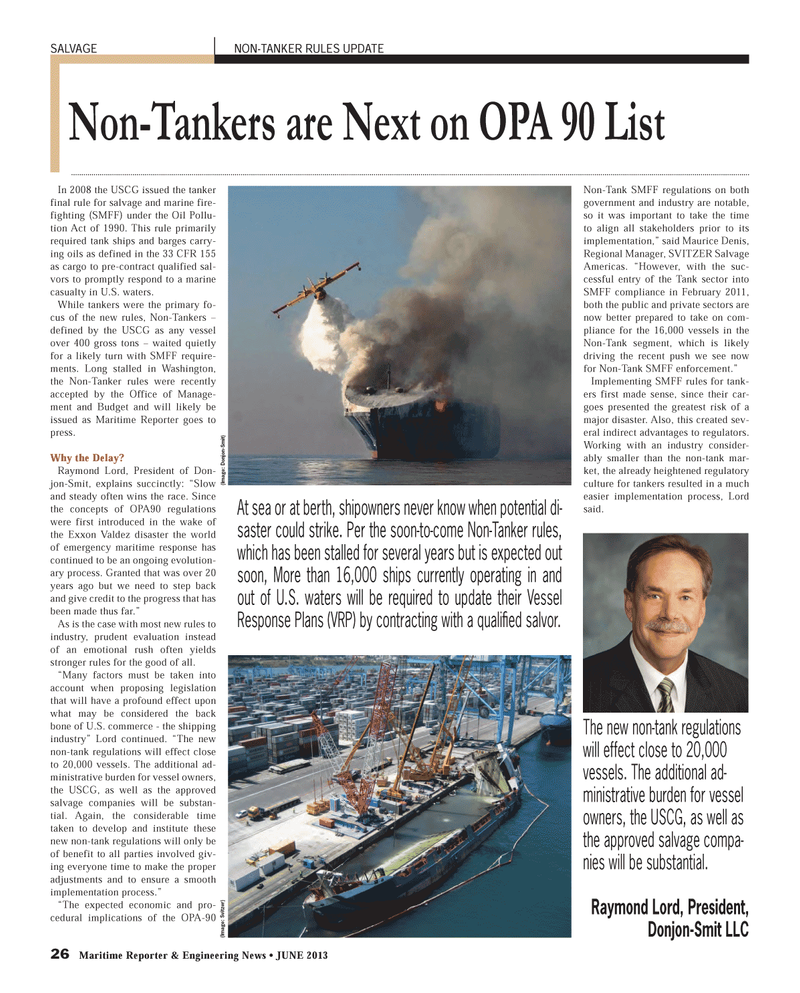
Page 26: of Maritime Reporter Magazine (June 2013)
Annual World Yearbook
Read this page in Pdf, Flash or Html5 edition of June 2013 Maritime Reporter Magazine
26 Maritime Reporter & Engineering News ? JUNE 2013 In 2008 the USCG issued the tanker final rule for salvage and marine fire-fighting (SMFF) under the Oil Pollu-tion Act of 1990. This rule primarily required tank ships and barges carry- ing oils as defined in the 33 CFR 155 as cargo to pre-contract qualified sal- vors to promptly respond to a marine casualty in U.S. waters. While tankers were the primary fo-cus of the new rules, Non-Tankers ? defined by the USCG as any vessel over 400 gross tons ? waited quietly for a likely turn with SMFF require-ments. Long stalled in Washington, the Non-Tanker rules were recently accepted by the Office of Manage- ment and Budget and will likely be issued as Maritime Reporter goes to press.Why the Delay?Raymond Lord, President of Don-jon-Smit, explains succinctly: ?Slow and steady often wins the race. Since the concepts of OPA90 regulations were first introduced in the wake of the Exxon Valdez disaster the world of emergency maritime response has continued to be an ongoing evolution-ary process. Granted that was over 20 years ago but we need to step back and give credit to the progress that has been made thus far.? As is the case with most new rules to industry, prudent evaluation instead of an emotional rush often yields stronger rules for the good of all.?Many factors must be taken into account when proposing legislation that will have a profound effect upon what may be considered the back bone of U.S. commerce - the shipping industry? Lord continued. ?The new non-tank regulations will effect close to 20,000 vessels. The additional ad- ministrative burden for vessel owners, the USCG, as well as the approved salvage companies will be substan-tial. Again, the considerable time taken to develop and institute these new non-tank regulations will only be of benefit to all parties involved giv-ing everyone time to make the proper adjustments and to ensure a smooth implementation process.??The expected economic and pro-cedural implications of the OPA-90 Non-Tank SMFF regulations on both government and industry are notable, so it was important to take the time to align all stakeholders prior to its implementation,? said Maurice Denis, Regional Manager, SVITZER Salvage Americas. ?However, with the suc- cessful entry of the Tank sector into SMFF compliance in February 2011, both the public and private sectors are now better prepared to take on com-pliance for the 16,000 vessels in the Non-Tank segment, which is likely driving the recent push we see now for Non-Tank SMFF enforcement.? Implementing SMFF rules for tank-ers first made sense, since their car- goes presented the greatest risk of a major disaster. Also, this created sev- eral indirect advantages to regulators. Working with an industry consider- ably smaller than the non-tank mar- ket, the already heightened regulatory culture for tankers resulted in a much easier implementation process, Lord said.SALVAGE NON-TANKER RULES UPDATE Non-Tankers are Next on OPA 90 List (Image: Svitzer)(Image: Donjon-Smit)At sea or at berth, shipowners never know when potential di- saster could strike. Per the soon-to-come Non-Tanker rules, which has been stalled for several years but is expected out soon, More than 16,000 ships currently operating in and out of U.S. waters will be required to update their Vessel Response Plans (VRP) by contracting with a qualiÞ ed salvor. The new non-tank regulations will effect close to 20,000 vessels. The additional ad-ministrative burden for vessel owners, the USCG, as well as the approved salvage compa- nies will be substantial. Raymond Lord, President, Donjon-Smit LLCMR #6 (26-33).indd 26MR #6 (26-33).indd 265/31/2013 11:52:26 AM5/31/2013 11:52:26 AM

 25
25

 27
27
